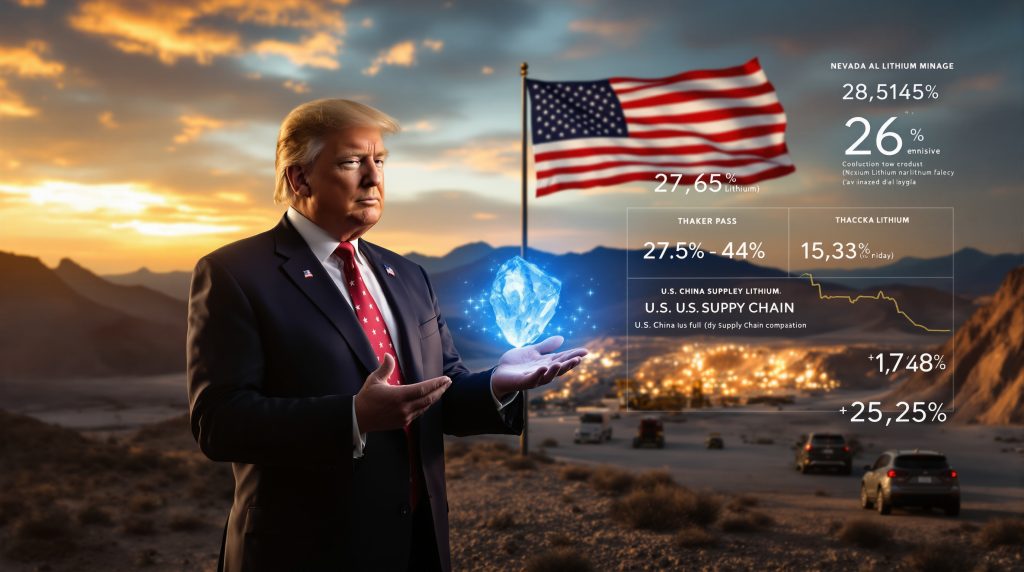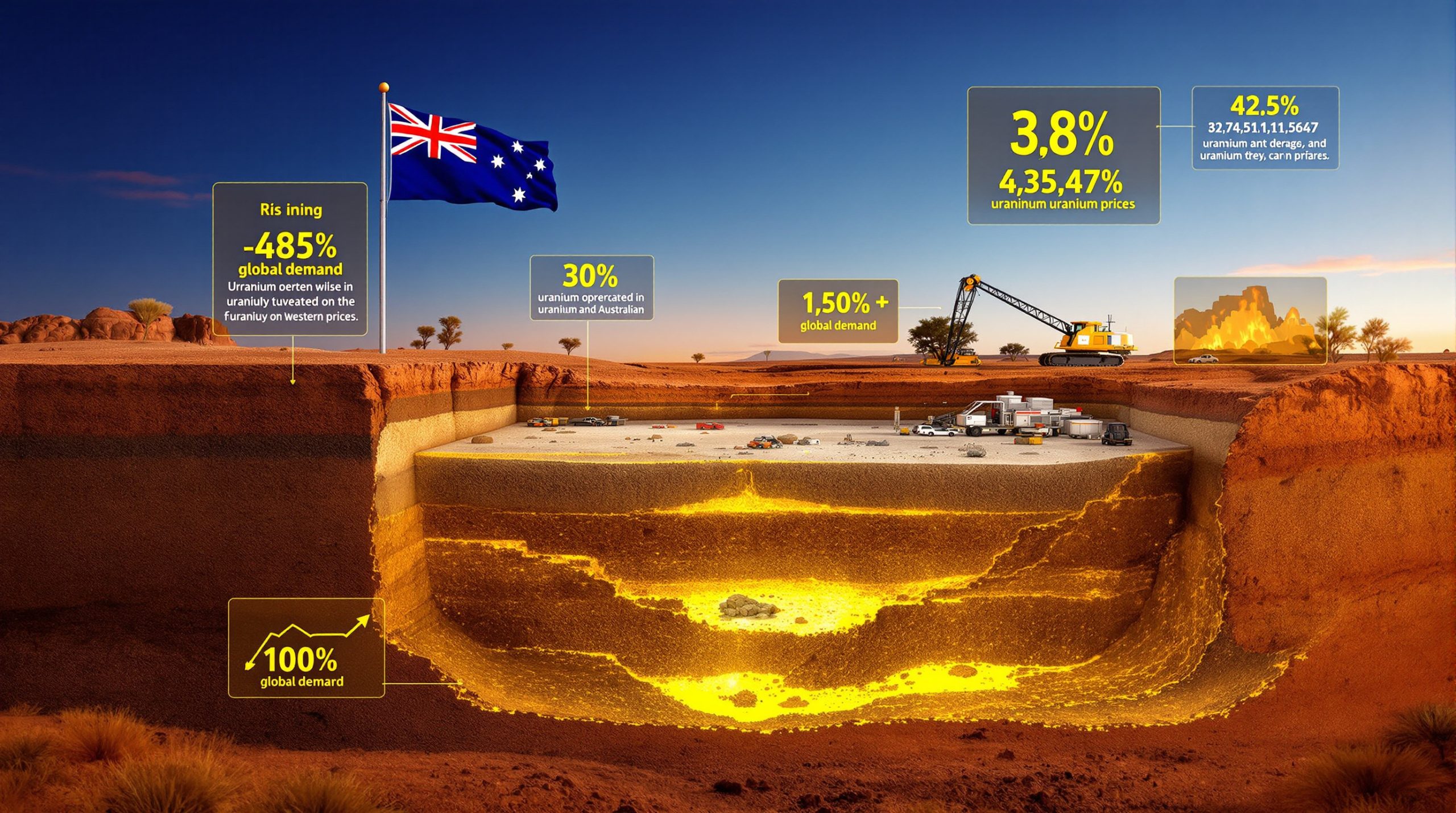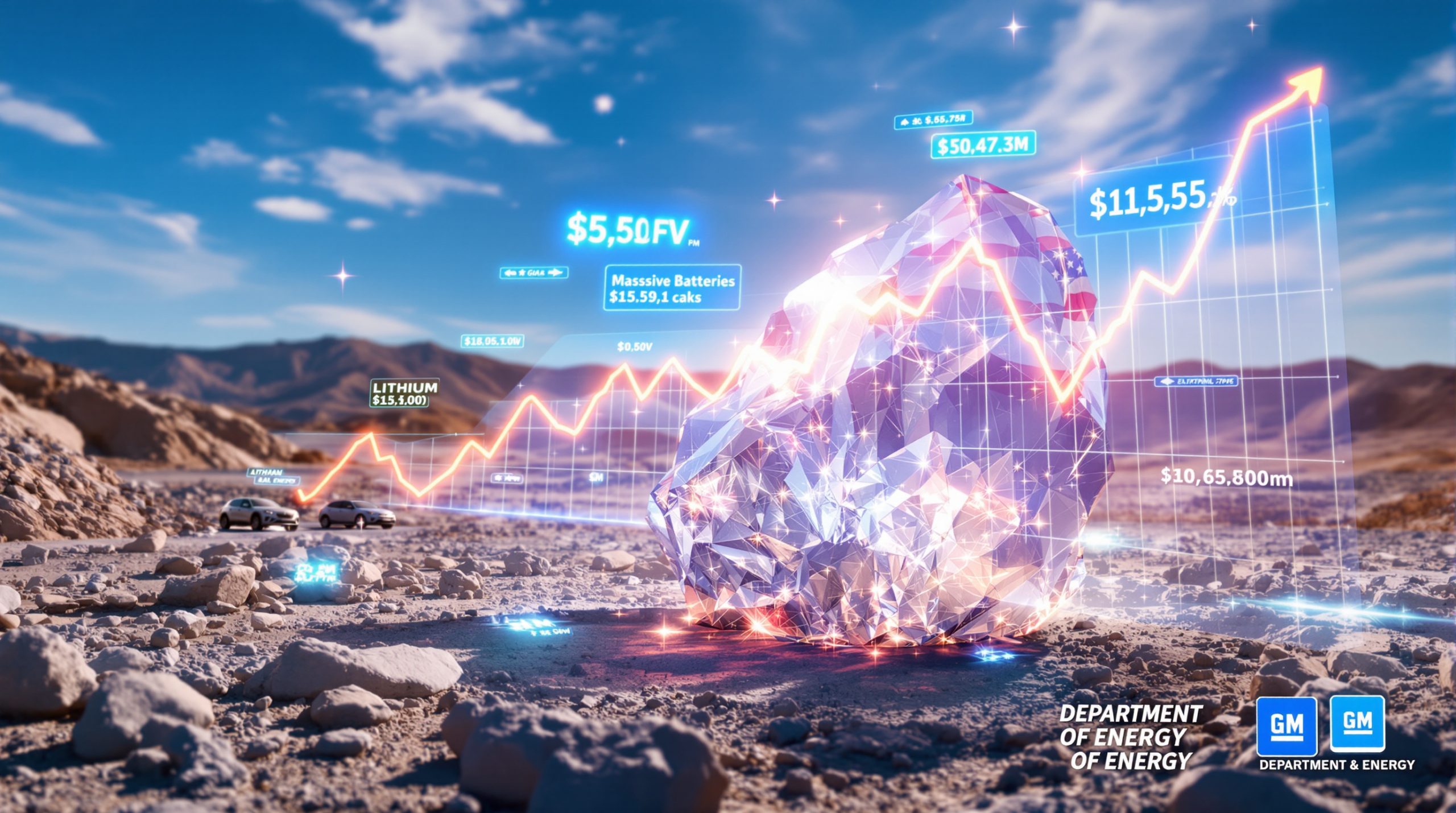Trump's Strategic Move: The U.S. Government's Equity Stake in Thacker Pass Lithium
The United States government is taking unprecedented steps to secure domestic lithium supplies through direct equity involvement in strategic mineral projects. This approach represents a fundamental shift in how America addresses resource security for the critical minerals energy transition, with Thacker Pass positioned as the cornerstone of this new strategy.
Recent negotiations between Washington and Lithium Americas reveal a potential 10% government ownership stake in the massive Nevada project, signaling a hands-on approach to securing critical minerals amid growing concerns about supply chain vulnerabilities and China's market dominance.
What is the Trump Administration's Lithium Strategy?
The shift toward government equity participation in critical minerals projects represents a transformative approach to securing America's clean energy future. Rather than relying solely on private investment, this strategy acknowledges the strategic importance of lithium as both an economic and national security priority.
With the U.S. currently producing less than 1% of global lithium despite having significant reserves, direct investment addresses a critical gap in American industrial capacity. According to the U.S. Geological Survey's 2024 assessment, domestic lithium production remains woefully inadequate compared to America's growing needs for battery manufacturing and energy storage.
This approach builds upon existing policy frameworks, including the 2022 Defense Production Act invocation for critical minerals and the Infrastructure Investment and Jobs Act's allocation of $6 billion for battery material processing facilities. The Department of Energy's Loan Programs Office has similarly prioritized lithium projects through its Advanced Technology Vehicles Manufacturing program.
Industry analysts note that this hands-on strategy mirrors approaches used successfully in other nations, creating a new public-private model for resource development where national interests and market dynamics intersect.
How Significant is the Thacker Pass Lithium Project?
The Scale and Potential of America's Largest Lithium Resource
Thacker Pass represents a transformative opportunity for U.S. mineral independence. Located in Humboldt County, northern Nevada, it stands as the Western Hemisphere's largest lithium development project with game-changing production potential.
The project spans approximately 17,933 acres of resource-rich land, according to the Bureau of Land Management's Environmental Impact Statement. When operational, Phase 1 will produce 40,000 tonnes of battery-quality lithium carbonate annually, as confirmed in Lithium Americas' SEC filings.
This production capacity will increase current U.S.-sourced lithium production by nearly tenfold, dramatically reducing reliance on foreign suppliers. The Nevada Governor's Office estimates the project will create approximately 1,000 construction jobs, with hundreds of permanent positions following completion.
Unlike many international projects, Thacker Pass utilizes innovative claystone ore processing rather than traditional brine extraction, potentially offering environmental advantages while maximizing resource recovery.
The Existing Corporate Structure and Partnerships
The Thacker Pass ownership structure highlights the emerging public-private collaboration in critical minerals:
| Stakeholder | Ownership Percentage | Investment Amount |
|---|---|---|
| Lithium Americas | 62% (current) | Developer |
| General Motors | 38% | $625 million |
| U.S. Government | 10% (proposed) | Part of $2.26B loan renegotiation |
General Motors secured its stake in January 2023, demonstrating the automotive industry's growing recognition of supply chain vulnerabilities. This partnership ensures GM will have priority access to domestic lithium for its expanding electric vehicle production.
The Department of Energy's $2.26 billion conditional loan commitment in 2023 provided essential financing, with negotiations now focusing on potential equity participation as part of a restructured agreement.
Why is Government Ownership in Critical Minerals Increasing?
The National Security Dimension
The strategic importance of critical minerals extends well beyond economic considerations into core national security interests. The Department of Defense has formally identified supply chain vulnerabilities in critical minerals as a significant national security concern, according to their 2022 Supply Chain Resilience Report.
This security-focused approach explains why government equity participation is emerging as a preferred strategy over traditional loan programs or tax incentives. Direct ownership ensures governmental influence over production allocation, processing methods, and downstream integration.
The precedent for this approach exists in the MP Materials partnership with the Department of Defense, which established government equity participation in rare earth production. This public-private model provided MP Materials with capital while ensuring national security interests remained prioritized.
Historical parallels exist from World War II when the federal government took direct ownership positions in aluminum and other strategic industries deemed essential for military production.
Market Response to Government Participation
Financial markets have responded positively to federal involvement in critical minerals projects, recognizing that government backing reduces project risk while enhancing long-term viability.
This investor confidence reflects several advantages of government participation:
- Reduced permitting barriers and regulatory uncertainty
- Enhanced access to capital at favorable rates
- Improved project credibility with downstream partners
- Greater protection against market manipulation by foreign entities
- Long-term demand stability through government procurement
These factors create a virtuous cycle where government participation attracts additional private investment, accelerating development timelines while distributing financial risk.
How Does the U.S. Compare to China in Critical Minerals?
The Global Supply Chain Imbalance
Despite recent U.S. initiatives, China maintains overwhelming dominance in critical minerals processing and production. According to the International Energy Agency's 2024 Critical Minerals Market Review, China controls approximately 70% of refining capacity across 19 of 20 key critical minerals.
This dominance extends throughout the value chain:
- China produces approximately 70% of the world's lithium hydroxide
- Its market share in critical mineral processing has increased from 50% to 70% over the past decade
- Rare earth permanent magnet production is 85% concentrated in Chinese facilities
- Processing capacity represents a greater bottleneck than mining capacity
The supply concentration creates vulnerability to export restrictions, price manipulation, and geopolitical leverage. As the IEA notes, critical mineral prices have shown volatility three times greater than traditional commodities, creating significant economic risks.
The Race to Diversify Supply Chains
The U.S. faces considerable challenges in building competitive supply chains that can effectively counter China's dominant position:
- Current domestic lithium production is limited to a single operating mine at Silver Peak, Nevada, producing approximately 5,000 tonnes annually
- Processing infrastructure lags significantly behind extraction capabilities
- Permitting timelines and environmental reviews extend development schedules
- Capital requirements for full supply chain development exceed typical mining investments
International partnerships offer partial solutions, with Australia producing 55% of global lithium and Chile producing 26%. However, both nations export most raw materials to China for processing, highlighting the need for domestic processing capacity.
What Terms is the Administration Seeking in the Thacker Pass Deal?
The Loan Renegotiation Process
The Administration is reportedly renegotiating the terms of the $2.26 billion Department of Energy loan originally secured for the Thacker Pass project. While specific details remain confidential, key aspects likely include:
- Potential conversion of debt to equity to provide government ownership
- Restructuring of amortization schedules to balance taxpayer protection with project viability
- Implementation of operational oversight provisions to ensure strategic alignment
- Establishment of production allocation guarantees for domestic manufacturing
This approach represents an evolution from traditional loan programs toward more direct investment models that provide taxpayers with potential upside while sharing project risk.
Precedents for Government Equity in Resource Projects
This approach builds on historical precedents where the federal government has taken direct ownership positions in strategic industries:
- The Defense Production Act Title III program has historically supported strategic material production
- The Reconstruction Finance Corporation of the 1930s-1940s took equity positions in critical industries
- International models from countries like Australia and Canada have demonstrated successful government equity participation in critical resource projects
Trump's critical minerals order appears to be adapting these frameworks to address the unique challenges of building a domestic lithium supply chain, creating potential models for future critical mineral investments.
How Will This Impact the U.S. Battery Supply Chain?
Downstream Manufacturing Integration
The Thacker Pass project represents a cornerstone of America's emerging battery supply chain. Its development will support numerous downstream applications:
- Electric vehicle manufacturing across multiple automakers
- Stationary storage systems for grid resilience
- Consumer electronics production
- Advanced defense applications requiring high-performance batteries
Tesla's Nevada Gigafactory alone requires approximately 15,000 tonnes of lithium annually, while Ford's bet on Thacker Pass lithium reflects their battery commitments requiring 120,000 tonnes of lithium carbonate by 2030, according to their respective SEC filings.
By securing domestic lithium production, the U.S. can better attract and retain battery cell manufacturing, cathode production, and other downstream value chain components that currently concentrate in regions with reliable material access.
Economic Impact Projections
The development of Thacker Pass is expected to generate substantial economic benefits beyond direct employment:
- Creation of specialized supply chain jobs throughout the processing ecosystem
- Technology transfer opportunities with research institutions and universities
- Reduced trade deficits through import substitution
- Tax revenue generation for local and federal governments
- Economic multiplier effects in manufacturing communities
These economic advantages help explain the Administration's willingness to consider direct equity participation rather than relying solely on traditional financing mechanisms.
What Are the Environmental Considerations?
Sustainable Mining Practices
The Thacker Pass project has incorporated numerous environmental innovations to address potential concerns about lithium extraction:
- Water recycling systems to minimize consumption in the arid Nevada environment
- Carbon capture initiatives to reduce emissions from processing
- Habitat conservation plans for local wildlife, including specific sage grouse habitat mitigation covering 3,054 acres
- Mine reclamation innovations exceeding regulatory requirements, backed by a $58.7 million reclamation bond
These measures reflect the recognition that domestic production must meet higher environmental standards than those often found in overseas operations, particularly in developing nations with less stringent regulations.
Regulatory Compliance and Community Engagement
The project has navigated complex regulatory requirements at multiple levels:
- Bureau of Land Management Final Environmental Impact Statement covering 17,933 acres
- Nevada Division of Environmental Protection permits with strict monitoring requirements
- U.S. Fish and Wildlife Service habitat assessment and mitigation plans
- Extensive public comment periods allowing community input
The water usage requirements of 1,730 gallons per minute from groundwater sources have received particular scrutiny, with ongoing monitoring to ensure sustainable utilization of this precious resource in Nevada's arid environment.
What Does This Mean for Future Critical Mineral Projects?
A New Model for Public-Private Partnership
The Thacker Pass equity arrangement may establish a template for future critical mineral developments by providing a balanced approach to risk-sharing and benefit distribution:
- Government equity participation providing capital while reducing project risk
- Production allocation guarantees ensuring domestic benefit
- Streamlined permitting processes for strategically important resources
- Coordinated offtake arrangements with domestic manufacturers
This integrated approach could accelerate the development timeline for projects that might otherwise struggle to secure financing or navigate regulatory requirements, particularly for minerals with volatile market pricing or complex processing requirements.
Potential Expansion to Other Critical Minerals
The Administration's approach to Thacker Pass lithium could expand to other critical minerals where supply chain vulnerabilities exist:
- Nickel and cobalt for battery cathodes
- Graphite for battery anodes
- Rare earth elements for permanent magnets
- Manganese, copper, and other battery metals
Each of these materials faces similar supply chain concentration challenges that might benefit from direct government involvement, particularly where processing technology or market dynamics create barriers to purely private investment.
How Will This Affect International Mineral Markets?
Market Signal Effects
The U.S. government's direct equity participation sends powerful signals to international markets that extend beyond the immediate financial impact:
- Demonstrates long-term commitment to domestic production
- Potentially influences investment decisions by allied nations seeking to secure their own supply chains
- Creates competitive pressure on existing suppliers to maintain market access
- May accelerate similar initiatives by strategic partners
These market signals could reshape global investment patterns in critical minerals, particularly if they succeed in accelerating project development timelines and reducing financial risk.
Geopolitical Implications
The Administration's approach to critical minerals has significant geopolitical dimensions that extend beyond economic considerations:
- Reduces leverage that resource-controlling nations can exert on U.S. manufacturing
- Creates opportunities for allied cooperation on mineral security
- Establishes precedents for resource nationalism in Western economies
- Potentially influences trade negotiations and international agreements
These geopolitical considerations help explain why the Administration views critical mineral investments through a national security lens rather than purely economic calculations, with implications for future international resource governance.
What's Next for the Thacker Pass Project?
Development Timeline and Milestones
With potential government equity participation, the Thacker Pass project faces several key milestones on its path to production:
- Finalization of loan renegotiation terms with the Department of Energy
- Continued construction and development activities at the Nevada site
- Equipment procurement and installation for processing facilities
- Workforce development and training programs for operations
- Commissioning and production ramp-up
While mechanical completion was originally targeted for late 2027, the involvement of government equity could potentially accelerate certain aspects of development, particularly permitting and regulatory approvals.
Monitoring Progress and Accountability
The Administration's equity stake will likely include robust monitoring mechanisms to ensure both financial and strategic objectives are met:
- Regular reporting requirements on construction progress
- Financial performance metrics and variance analysis
- Environmental compliance verification with public transparency
- Production allocation tracking to ensure domestic benefits
- Technology development milestones to enhance processing efficiency
These accountability measures reflect the dual objectives of protecting taxpayer investments while advancing strategic resource security objectives that serve broader national interests.
The Shifting Landscape of Critical Mineral Security
The government's pursuit of an equity stake in Thacker Pass represents a fundamental shift in how the U.S. approaches critical mineral security. By moving beyond regulatory frameworks and financial incentives to direct ownership, this strategy signals both the strategic importance of these resources and the inadequacy of traditional approaches to securing supply chains.
This evolution mirrors similar developments in defense procurement, energy security, and other areas where national interests intersect with market dynamics. As global competition for critical minerals intensifies, direct government participation may become an increasingly common feature of resource development projects.
For investors, manufacturers, and policymakers, the Thacker Pass equity arrangement offers a glimpse into the future of public-private collaboration in strategic sectors – one where government assumes a more active role in ensuring access to the materials underpinning both economic prosperity and national security.
The approach acknowledges that in an era of resource competition and supply chain vulnerability, lithium industry tax breaks and incentives alone are insufficient. By taking an ownership stake rather than simply providing financing, the government gains both leverage and alignment with project outcomes, creating a new model for securing America's mineral future. Furthermore, the development of a battery-grade lithium refinery infrastructure will be essential to fully capitalize on domestic lithium resources like Thacker Pass.
According to detailed reporting from Reuters, Trump places direct bet on Thacker Pass lithium not just as an economic investment but as a strategic pillar of American resource independence.
Looking to Invest in the Next Major Mineral Discovery?
Stay ahead of the market with Discovery Alert's proprietary Discovery IQ model, which instantly notifies investors of significant ASX mineral discoveries and translates complex mineral data into actionable insights. Visit Discovery Alert's dedicated discoveries page at https://discoveryalert.com.au/discoveries/ to understand why historic discoveries can generate substantial returns for early investors.




